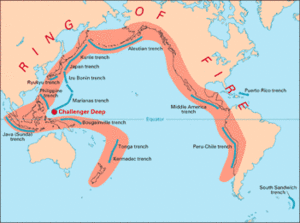DisastersMega-quake hotspots around the world
The 2010 earthquake in Haiti killed hundreds of thousands and destroyed large sections of the capital, Port au Prince; the clock is ticking on many earthquake faults throughout the world, and a comprehensive new book points to places around the world that could face the fate of Port au Prince

The famous Pacific RIng of Fire is one of the major hot spots // Source: usgs.gov
At the beginning of 2010, Oregon State University geologist Bob Yeats told a national reporter that Port au Prince, Haiti, was a “time bomb” for a devastating earthquake because of its crowded, poorly constructed buildings and its proximity to the Enriquillo Fault.
One week later, a magnitude 7 earthquake destroyed Port au Prince, killing hundreds of thousands of people and devastating the economy of Haiti.
An Oregon State University release quotes Yeats to say that the clock is ticking on many other earthquake faults throughout the world, and though he did not “predict” the Haiti earthquake, he can point to other places that could face the same fate. He outlines some of these areas in a new book called Active Faults of the World, published by Cambridge University Press.
“We are not yet to the point where we can predict earthquakes,” said Yeats, a professor emeritus in Oregon State’s College of Earth, Ocean, and Atmospheric Sciences. “What we can do is tell you where some of the most dangerous faults lie – and where those coincide with crowded cities, few building codes, and a lack of social services, you have a time bomb.
“Unfortunately, we can’t say if an earthquake will strike today, tomorrow or in a hundred years,” he added. “But in all of these locations it will happen someday – and unless something is done to improve conditions, many thousands of people will die.”
In his book, Yeats notes that the greatest migration in human history is of people moving from rural areas to “megacities” in the developing world. People have flocked to these mega-cities where multi-level housing and businesses are rapidly built, and often poorly constructed and poorly inspected. When many of these locations last had a major earthquake, their population was small and a majority of the people was living in one-story dwellings, limiting the loss of life.
Yeats cites as an example Caracas, Venezuela, which has an earthquake plate-boundary fault north of the city. In 1812 a major quake shook Caracas and other Venezuelan cities and killed an estimated 10,000 people — about 10 percent of the population at that time. Today, the population of Caracas is nearly 3 million, but government decision-makers are “not placing earthquake hazards high on their list of priorities,” Yeats said, despite the presence of knowledgeable local experts.
Another city near the top of Yeats’ list of earthquake dangers is Kabul, Afghanistan, which
